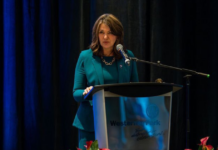Alberta electricity data shows that power generated by wind farms throughout the province grinded to a near halt on Thursday.
As first reported by Pipeline Online, by suppertime on Feb. 23 wind farms were producing on average between 11 and 20 megawatts – about 0.3% of their 3,618 megawatts capacity.
Part of the reason behind the decline in energy production was due to extreme cold weather conditions which trigger wind turbines to go into hibernation. Wind turbines could break in below -30 C temperatures.
Alberta also saw low levels of wind ranging between 3 kilometres per hour to 5 kilometres per hour in some regions.
Out of Alberta’s 36 wind farms, only 11 megawatts of electricity was being produced. A vast majority – 31 turbines – were not operational at all.
As noted by the Twitter account Reliable AB Energy, at that time Alberta’s electrical grid was relying on fossil fuels with 91.3% of the energy produced being attributed to that source.
“Wind is at 0.4% of capacity and producing 0.1% of total generation, while solar is at 33.2% of capacity and producing 3.61% of total generation. At the same time we are importing 811 MW or 7%,” tweeted the account which tracks Alberta’s energy grid.
Despite this unreliability in energy production, Alberta is seeking to add yet another wind farm to its repertoire.
TransAlta Corporation is currently planning to build a new wind power plant in Cardston County with up to 50 operational turbines.
Some residents have not taken well to the proposal arguing that the plan wasn’t well communicated and could disrupt business and local wildlife.
“There is inherent value in wild spaces and we have far too few intact landscapes left and this is one of them,” resident Julia Palmer told Global News.






















